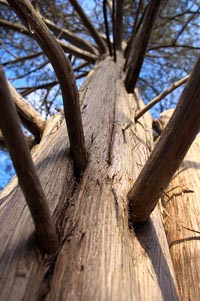Name That Tree
The correct answer is b. Eastern Red Cedar(Juniperus virginiana). Notice the common name indicates it is a cedar, but it is, in fact, a juniper.

Eastern Red Cedar stringy bark
One sure indicator that the tree is Eastern Red Cedar is its stringy bark. Eastern Red Cedar is not a particular favorite of gardeners, who often consider it either unsightly or weedy. But it is a good choice for screening. It is not a bad street tree either. It is tough, relatively fast growing, easy to transplant, very heat tolerant, and hardy in zones 2-9. It requires little pruning. It is also long-lived. Some specimens are estimated to be over 400 years old. It thrives in dry soil.
‘Globosa,’ ‘Grey Owl,’ and ‘Silver Spreader’ are low-growing cultivars that have been developed for landscaping. ‘Globosa’ is a dwarf with a spreading growth habit suitable for rock gardens. ‘Grey Owl’ grows to only 3 feet high and is used in borders. ‘Silver Spreader’ is used as a ground cover.
The twigs of Eastern Red Cedar are square in cross section. The tree is unusual in that it has two types of leaves: the stubby scales shown in the photo above and awl-shaped needles that appear on new growth. This can complicate the identification of the tree.

Needles and cone
Scaly needles and cones (it is a conifer) that resemble blueberries are characteristic of Eastern red cedar. Eastern Red Cedar is a conifer. The berry-like cones are favored food of cedar waxwings and other birds. The birds digest the fleshy part and pass the seeds often leaving them in open fields, along fence lines and under utility lines.
Because it is rot resistant, the wood of Eastern Red cedar has been used as fence posts and rails for split rail fences for many years. Its fragrance also accounts for its use to line boxes, chests, and closets.
Some beautiful exemplars of mature Eastern red cedars are located at Green Spring Gardens adjacent to the long border near the parking lot.
One significant drawback of Eastern Red Cedar is the fact that it is an alternate host of cedar apple rust that can damage apples, crab apples, and hawthorns. So you might want to avoid this one if you are into fruit trees. If you already have one of these trees, and you see orange golf ball-shaped galls on it, you have cedar apple rust.
Resources
Juniperus Virginiana, NC State Cooperative Extension,
Eastern Redcedar (Juniperus virginiana), Iowa State University Forestry Extension, Trees of Iowa Identification Key
Red Cedar: New Hampshire’s Big Tree of 2008, University of New Hampshire Cooperative Extension